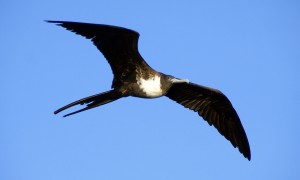The Florida Keys is an excellent place to see a wide variety of bird species. People flock to these islands from all over the world to get a glimpse at rare and unusual species that stop here during their migrations. We also have a great number of interesting birds that live here throughout the year. One bird often seen is the magnificent frigatebirds. Its large wingspan and v-shaped silhouette above the water is a welcome sight to those looking for a good fishing spot. There are five species of frigatebirds around the world, but the magnificent frigatebird is the only one that nests in Florida.

Magnificent Frigatebirds are so named because they reminded sailors of the sails of a warship, leading to another common name for these animals: man-o-war birds. They have a seven-and-a-half-foot wing span, which is very large when compared to their body. In fact, they have the largest wing span, compared to body size, of any bird. Magnificent frigatebirds catch their prey close to the surface of the water. They use their hooked bills to catch fish and squid that come close to the surface as they are being chased by other underwater predators. Seasoned anglers commonly look for these birds when searching for a good spot to put hooks in the water.
Frigatebirds will also find and eat chicks of other bird species. Another way they get food is by stealing it from other seabirds. The most magnificent behavior of frigatebirds is that they can travel long distances without rest. Scientists have found that these birds can fly for months without pause. Some have been recorded traveling thousands of miles from their nesting site in search of food. The feathers of a frigatebird are not waterproof or oily. Therefore, they cannot stop and rest on the surface of the water without sinking. How can they fly for miles without resting? Frigatebirds use columns of warm, rising air, known as thermals, to ascend without much effort on their part. These thermals allow frigatebirds to rest and even sleep. In order to rest, a frigatebird can shut off half of its brain but continue to fly. Frigatebirds sleep in short, 10-second intervals.
Frigatebirds don’t have a great deal of predators, but nesting sites may be compromised by feral cats and invasive rats. Frigatebirds are often found flying high above the water, so a great place to have a chance at seeing these magnificent birds is by boat. At John Pennekamp Coral Reef State Park, you can catch a ride on a glass bottom or snorkel boat tour, or rent a kayak. Just remember to look up.
Visit floridastateparks.org to plan your birding adventure today.
Dan Szopinski is a park ranger at John Pennekamp Coral Reef State Park.
